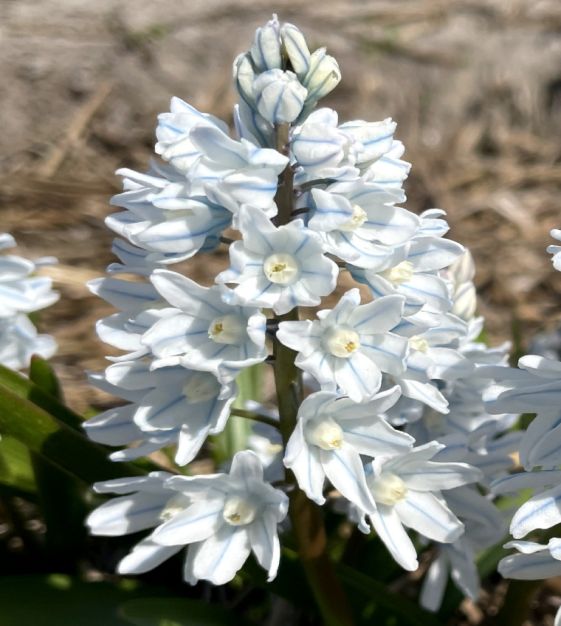-
- Website Specials
- New for 2025!
- Tulips
- Narcissi
- Allium
- Anemone blanda
- Brodiaea
- Camassia
- Chionodoxa
- Corydalis
- Crocus
- Eranthis
- Eremurus
- Erythronium
- Fritillaria
- Galanthus
- Geranium
- Gladiolus
- Hyacinths
- Hyacinthoides
- Ipheion uniflorum
- Dutch Iris
- Rock Garden Iris
- Ixiolirion
- Leucojum Aestivum
- Muscari
- Ornithogalum
- Oxalis
- Puschkinia
- Scilla
- Lilies
- Peonies
- Tender Bulbs
- Anemone Giants
- Tecolote Ranunculus
- Freesias
- Paperwhites
- Amaryllis
Puschkinia scilloides var libanotica
The Striped Squill is a deer- and rodent-resistant naturalizer native to the Caucasus, circa 1808. It is best grown in moist, fertile, well-draining soil in full sun to partial sunlight. It yields numerous stems of six to eight, little, rounded, star-shaped pale blue-white flowers with deep blue midveins and strappy, shiny foliage. Puschkinia takes time to mature, and if it’s happy where it’s planted and left undisturbed, it naturalizes by bulb offsets (called bulblets: baby bulbs on the sides of the mother bulb you’ve planted), and maybe even by self-sowing seed. It’s terrific planted en masse in garden borders, sunny woodland borders and rock gardens. If they are incorporated into lawn plantings, please hold off lawn mowing for a good six weeks.
You’ll need nine bulbs per square foot. Bulb size: 6 cm/up. Full to partial sunlight. Bloom time in horticultural zone 5: April. Plant 4" deep and 4" apart. HZ: 4-8. Height: 5".
Puschkinia scilloides is The Art & Soul of Spring.
Puschkinia Horticultural Tips Stinze Plantings
Puschkinia scilloides is The Art & Soul of Spring.
Puschkinia Horticultural Tips Stinze Plantings
- Information
Puschkinia
Closely related to Chionodoxa and Scilla, The Striped Squill is a deer- and rodent-resistant naturalizer named after Russian botanist Count Apollos Apollosvich Mussin-Puschkin. Native to the Caucasus, circa 1800, Puschkinia is best grown in moist, fertile, well-draining soil in full sun to partial sunlight. Unlike most bulbs, it can handle, and may even prefer, soil that has a bit more moisture (but never in a spot that gets waterlogged at any time). It yields numerous stems of six to eight, little, rounded, star-shaped flowers with deep blue midveins and strappy, shiny foliage. Puschkinia takes time to mature, and if it’s happy where it’s planted and left undisturbed, it naturalizes by bulb offsets (called bulbils: baby bulbs on the sides of the mother bulb you’ve planted), and maybe even by self-sowing seed. It’s terrific planted en masse in garden borders, sunny woodland borders and rock gardens. (Puschkinia is also good for forcing indoors over the winter. Pot them up in mid-October and precool them at a consistent, dark 38°F to 45°F for six to eight weeks with moderate watering. Bring them into the house~they will bloom about two to four weeks later.)
You’ll need nine bulbs per square foot. (Square footage is determined multiplying the planting site’s length times its width.) Top size bulbs. Full to partial sunlight. Bloom time in horticultural zone 5: April. Plant 4" deep and 4" apart. HZ: 4-8. Height: 5".
Puschkinia sciolliodes is The Art & Soul of Spring.
Puschkinia Horticultural Tips Stinze Plantings
Closely related to Chionodoxa and Scilla, The Striped Squill is a deer- and rodent-resistant naturalizer named after Russian botanist Count Apollos Apollosvich Mussin-Puschkin. Native to the Caucasus, circa 1800, Puschkinia is best grown in moist, fertile, well-draining soil in full sun to partial sunlight. Unlike most bulbs, it can handle, and may even prefer, soil that has a bit more moisture (but never in a spot that gets waterlogged at any time). It yields numerous stems of six to eight, little, rounded, star-shaped flowers with deep blue midveins and strappy, shiny foliage. Puschkinia takes time to mature, and if it’s happy where it’s planted and left undisturbed, it naturalizes by bulb offsets (called bulbils: baby bulbs on the sides of the mother bulb you’ve planted), and maybe even by self-sowing seed. It’s terrific planted en masse in garden borders, sunny woodland borders and rock gardens. (Puschkinia is also good for forcing indoors over the winter. Pot them up in mid-October and precool them at a consistent, dark 38°F to 45°F for six to eight weeks with moderate watering. Bring them into the house~they will bloom about two to four weeks later.)
You’ll need nine bulbs per square foot. (Square footage is determined multiplying the planting site’s length times its width.) Top size bulbs. Full to partial sunlight. Bloom time in horticultural zone 5: April. Plant 4" deep and 4" apart. HZ: 4-8. Height: 5".
Puschkinia sciolliodes is The Art & Soul of Spring.
Puschkinia Horticultural Tips Stinze Plantings
Puschkinia
Closely related to Chionodoxa and Scilla, The Striped Squill is a deer- and rodent-resistant naturalizer named after Russian botanist Count Apollos Apollosvich Mussin-Puschkin. Native to the Caucasus, circa 1800, Puschkinia is best grown in moist, fertile, well-draining soil in full sun to partial sunlight. Unlike most bulbs, it can handle, and may even prefer, soil that has a bit more moisture (but never in a spot that gets waterlogged at any time). It yields numerous stems of six to eight, little, rounded, star-shaped flowers with deep blue midveins and strappy, shiny foliage. Puschkinia takes time to mature, and if it’s happy where it’s planted and left undisturbed, it naturalizes by bulb offsets (called bulbils: baby bulbs on the sides of the mother bulb you’ve planted), and maybe even by self-sowing seed. It’s terrific planted en masse in garden borders, sunny woodland borders and rock gardens. (Puschkinia is also good for forcing indoors over the winter. Pot them up in mid-October and precool them at a consistent, dark 38°F to 45°F for six to eight weeks with moderate watering. Bring them into the house~they will bloom about two to four weeks later.)
You’ll need nine bulbs per square foot. (Square footage is determined multiplying the planting site’s length times its width.) Top size bulbs. Full to partial sunlight. Bloom time in horticultural zone 5: April. Plant 4" deep and 4" apart. HZ: 4-8. Height: 5".
Puschkinia sciolliodes is The Art & Soul of Spring.
Puschkinia Horticultural Tips Stinze Plantings
Closely related to Chionodoxa and Scilla, The Striped Squill is a deer- and rodent-resistant naturalizer named after Russian botanist Count Apollos Apollosvich Mussin-Puschkin. Native to the Caucasus, circa 1800, Puschkinia is best grown in moist, fertile, well-draining soil in full sun to partial sunlight. Unlike most bulbs, it can handle, and may even prefer, soil that has a bit more moisture (but never in a spot that gets waterlogged at any time). It yields numerous stems of six to eight, little, rounded, star-shaped flowers with deep blue midveins and strappy, shiny foliage. Puschkinia takes time to mature, and if it’s happy where it’s planted and left undisturbed, it naturalizes by bulb offsets (called bulbils: baby bulbs on the sides of the mother bulb you’ve planted), and maybe even by self-sowing seed. It’s terrific planted en masse in garden borders, sunny woodland borders and rock gardens. (Puschkinia is also good for forcing indoors over the winter. Pot them up in mid-October and precool them at a consistent, dark 38°F to 45°F for six to eight weeks with moderate watering. Bring them into the house~they will bloom about two to four weeks later.)
You’ll need nine bulbs per square foot. (Square footage is determined multiplying the planting site’s length times its width.) Top size bulbs. Full to partial sunlight. Bloom time in horticultural zone 5: April. Plant 4" deep and 4" apart. HZ: 4-8. Height: 5".
Puschkinia sciolliodes is The Art & Soul of Spring.
Puschkinia Horticultural Tips Stinze Plantings





